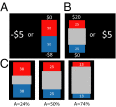Like cognitive function, decision making across the life span shows profound age-related changes
- PMID: 24082105
- PMCID: PMC3801020
- DOI: 10.1073/pnas.1309909110
Like cognitive function, decision making across the life span shows profound age-related changes
Erratum in
-
Correction for Tymula et al., Like cognitive function, decision making across the life span shows profound age-related changes.Proc Natl Acad Sci U S A. 2015 Oct 6;112(40):E5553. doi: 10.1073/pnas.1517212112. Epub 2015 Sep 11. Proc Natl Acad Sci U S A. 2015. PMID: 26362786 Free PMC article. No abstract available.
Abstract
It has long been known that human cognitive function improves through young adulthood and then declines across the later life span. Here we examined how decision-making function changes across the life span by measuring risk and ambiguity attitudes in the gain and loss domains, as well as choice consistency, in an urban cohort ranging in age from 12 to 90 y. We identified several important age-related patterns in decision making under uncertainty: First, we found that healthy elders between the ages of 65 and 90 were strikingly inconsistent in their choices compared with younger subjects. Just as elders show profound declines in cognitive function, they also show profound declines in choice rationality compared with their younger peers. Second, we found that the widely documented phenomenon of ambiguity aversion is specific to the gain domain and does not occur in the loss domain, except for a slight effect in older adults. Finally, extending an earlier report by our group, we found that risk attitudes across the life span show an inverted U-shaped function; both elders and adolescents are more risk-averse than their midlife counterparts. Taken together, these characterizations of decision-making function across the life span in this urban cohort strengthen the conclusions of previous reports suggesting a profound impact of aging on cognitive function in this domain.
Conflict of interest statement
The authors declare no conflict of interest.
Figures




References
-
- Reyna VF, Brainerd CJ. Fuzzy-trace theory: An interim synthesis. Learn Individ Differ. 1995;7(1):1–75.
-
- Spear LP. The Behavioral Neuroscience of Adolescence. New York: Norton; 2010.
-
- Park DC, et al. Models of visuospatial and verbal memory across the adult life span. Psychol Aging. 2002;17(2):299–320. - PubMed
-
- McArdle JJ, Ferrer-Caja E, Hamagami F, Woodcock RW. Comparative longitudinal structural analyses of the growth and decline of multiple intellectual abilities over the life span. Dev Psychol. 2002;38(1):115–142. - PubMed
Publication types
MeSH terms
Grants and funding
LinkOut - more resources
Full Text Sources
Other Literature Sources
Medical

